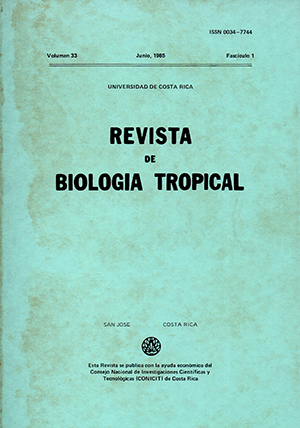Abstract
The squash and gourd bees, endemic to the Americas, are represented by 20 species, five of which are found in Costa Rica: four in the genus Peponapis and one in Xenoglossa. Since these two genera show a very close relationship, a series of common biological and morphological characters are given. According to the studies of Hurd and Linsley the majority of species (16) are found in Mexico, where the maximum development of Cucurbita occurs. This fact suggests that both plants and bees had their origin in Mexico, from where they migrated South and North. Keys are presented for identification of both sexes of the Costa Rican species. Additional information includes synonymical bibliographies and references. The squash and gourd bees virtually derive their entire economy from Cucurbita. Adaptive evolution between these bees and the flowers of Cucurbita is also shown, making the closely related genera Peponapis and Xenoglossa the best pollinators for the domestic or cultivated Cucurbita. Peponapis limitaris seems to be the best pollinator in Costa Rica, due to its wide distribution and abundance in this country, while Peponapis apiculata appears the better pollinator of Cucurbita ficifolia (chiverre) , which is cultivated at altitudes above 1000 meters.
References
Cockerell, T.D.A. 1906. The North American bees of the family Anthophoridae. Trans. Amer. Entomol. Soc., 32: 63-116.
Cockerell, T.D.A. 1912. Names applied to the eucerine bees of North America. Proc. U.S. Natl. Mus., 443: 261-273.
Cresson, E.T. 1878. Descriptions of new species of North American bees. Proc. Acad. Nat. Sci. Philadelphia. pp. 181-221.
Friese, H. 1916. Zur Bienenfauna von Costa Rica (Hym). Stettiner Entomol. Zeitg., 77: 287-324.
Friese, H. 1921. Nachtrag zur Bienenfauna von Costa Rica. Stettiner Entomol. Zeitg., 82: 74-98.
Hurd, P.D., Jr., & E.G. Linsley. 1964. The squash and gourd bees-genera Peponapis and Xenoglossa Smith-inhabiting America North of Mexico (Hymenoptera: Apoidea). Hilgardia, 35: 375-477.
Hurd, P.D., Jr., & E.G. Linsley. 1966. The Mexican squash and gourd bees of the genus Peponapis (Hymenoptera: Apoidea). Ann. Entomol. Soc. Amer., 59: 835-851.
Hurd, P.D., Jr., & E.G. Linsley. 1967a. South American squash and gourd bees of the genus Peponapis (Hymenoptera: Apoidea). Ann. Entomol. Soc. Amer., 60: 647-661.
Hurd, P.D., Jr., & E.G. Linsley. 1967b. Squash and gourd bees of the genus Xenoglossa (Hymenoptera: Apoidea). Ann. Entomol. Soc. Amer., 60: 988-1007.
Hurd, P.D., Jr., & E.G. Linsley. 1970. A classification of the squash and gourd bees (peponapis and Xenoglossa). Univ. Calif. Publ. Entomol., 62: 1-39.
Hurd, P.D., Jr., E.G. Linsley & T.W. Whitaker. 1971. Squash and gourd bees (Peponapis. Xenoglossa) and the origen of the cultivated Cucurbita. Evolution, 25: 218-234.
León, J. 1968. Fundamentos botánicos de los cultivos tropicales. Instituto Interamericano de Ciencias Agrícolas, Textos y Materiales de Enseñanza No. 18. San José, Costa Rica, 487 p.
Linares, O., & A. Ranere. 1980. Adaptive radiations in prehistoric Panamá. Peabody Museum Monographs. No. 5, Harvad University.
Michelbacher, A.E., P.D. Hurd, Jr., & E.G. Linsley. 1968. The feasibility of introducing squash bees (Peponapis and Xenoglossa) into the Old World. Bee World, 49: 159-167.
Michelbacher, A.E., P.D. Hurd, Jr. & E.G. Linsley. 1971. Experimental introduction of squash bees (Peponapis) to improve yields of squash, gourds and pumpkins. Bee World, 52: 156-166.
Millan, R. 1945. Variaciones del zapallito amargo "Cucurbita andreana" y el origen de Cucurbita maxima. Revista Argentina de Agronomía, 12: 86-93.
Whitaker, T.W., & H.C. Cutler, 1965. Cucurbits and cultures in the Americas. Econ. Bot., 119: 344-349.
Whitaker, T.W., & W.P. Bemis, 1965. Evolution in the genus Cucurbita. Evolution, 18: 553-559.
Wille, A., & E. Orozco. 1983. Polinización del chayote Sechium edule (Jacq.) Swartz en Costa Rica. Rev. Biol. Trop., 31: 145-154.
##plugins.facebook.comentarios##

This work is licensed under a Creative Commons Attribution 4.0 International License.
Copyright (c) 1985 Revista de Biología Tropical


